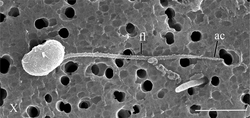Holozoa
Holozoa is a group of living things that includes animals, and some single-celled relatives of animals. It excludes fungi.[1][2][3][4] Holozoa is also an old name for the tunicate genus Distaplia.[5]
| Holozoa | |
|---|---|

| |
| Orange elephant ear sponge, Agelas clathrodes, in foreground. Two corals in the background: a sea fan, Iciligorgia schrammi, and a sea rod, Plexaurella nutans. | |
| Scientific classification | |
| (unranked): | Unikonta |
| (unranked): | Obazoa |
| (unranked): | Opisthokonta |
| (unranked): | Holozoa Lang et al., 2002 |
| Subgroups | |
| |
Holozoa is a clade: a group of plants or animals with a common ancestor. It has all organisms close to animals.[6]
An example of a well-known holozoan is the choanoflagellate, which looks a lot like the cells of a sponge. Proterospongia is an example of a choanoflagellate that might give clues as to how sponges evolved.
Evolution
The phylogenic tree (evolution tree) below shows how clades broke into newer clades. This includes Holozoa.
| Opisthokonta |
| ||||||||||||||||||||||||||||||||||||||||||||||||||||||||||||||||||||||||||||||||||||
Holozoa Media
Unicellular holozoans do not go through animal embryonic development, but they display developmental processes using similar molecules. An actomyosin network controls the cellularization of both an ichthyosporean coenocyte (A) and a fruit fly blastoderm (B).
References
- ↑ Aleshin VV, Konstantinova AV, Mikhailov KV, Nikitin MA, Petrov NB (December 2007). "Do we need many genes for phylogenetic inference?". Biochemistry Mosc. 72 (12): 1313–23. doi:10.1134/S000629790712005X. PMID 18205615. S2CID 12594007.
- ↑ Lang BF, O'Kelly C, Nerad T, Gray MW, Burger G (October 2002). "The closest unicellular relatives of animals". Curr. Biol. 12 (20): 1773–8. doi:10.1016/S0960-9822(02)01187-9. PMID 12401173. S2CID 14192333.
- ↑ Shalchian-Tabrizi, Kamran; Minge, Marianne A.; Espelund, Mari; Orr, Russell; Ruden, Torgeir; Jakobsen, Kjetill S.; Cavalier-Smith, Thomas; Aramayo, Rodolfo (7 May 2008). Aramayo, Rodolfo (ed.). "Multigene phylogeny of choanozoa and the origin of animals". PLOS ONE. 3 (5): e2098. Bibcode:2008PLoSO...3.2098S. doi:10.1371/journal.pone.0002098. PMC 2346548. PMID 18461162.
- ↑ Elias M, Archibald JM (August 2009). "The RJL family of small GTPases is an ancient eukaryotic invention probably functionally associated with the flagellar apparatus". Gene. 442 (1–2): 63–72. doi:10.1016/j.gene.2009.04.011. PMID 19393304.
- ↑ Tatiàn, Marcos; Antacli, Julieta Maria; Sahade, Ricardo (2005). "Ascidians (Tunicata, Ascidiacea): species distribution along the Scotia Arc". Scientia Marina. 69 (suppl. 2): 205–214. doi:10.3989/scimar.2005.69s2205.
- ↑ Steenkamp, Emma T.; Wright, Jane; Baldauf, Sandra L. (January 2006). "The Protistan Origins of Animals and Fungi". Molecular Biology & Evolution. 23 (1): 93–106. doi:10.1093/molbev/msj011. PMID 16151185.







